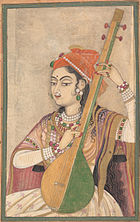Music of Jammu and Kashmir
hide | ||||||
| Music of India | ||||||
| Genres | ||||||
|---|---|---|---|---|---|---|
|
Traditional
Modern |
||||||
| Media and performance | ||||||
|
||||||
| Nationalistic and patriotic songs | ||||||
|
||||||
| Regional music | ||||||
|
||||||
Music of Jammu and Kashmir reflects a rich musical heritage and cultural legacy of the union territory of Jammu and Kashmir. Two different regions of Jammu and Kashmir, consists upper Jammu Division and Kashmir Valley. Music of Kashmir Valley is closer to Central Asian music[1] while music from Jammu region is similar to that of North India.
Kashmir[]
Chakri[]
Chakri is one of the most popular types of traditional music played in Jammu & Kashmir. Chakri is a responsorial song form with instrumental parts, and it is played with instruments like the harmonium, the rubab, the sarangi, the , the geger, the and the chimta. It is performed in folk and religious spheres, by the Muslim and Hindu kashmiris.[2] Chakri was also used to tell stories like fairy tales or famous love stories such as Yousuf-Zulaikha, Laila-Majnun, etc. Chakri ends with the rouf, though rouf is a dance form but few ending notes of Chakri which are played differently and on fast notes is also called Rouf.[3] It is a very important part of the Henna Night (Ma'enzi raat) during weddings.
Henzae[]
Henzae is a traditional and ancient form of singing which is practiced by Kashmiri Pandits at their festivals. It appears to have archaic features that suggest it is the oldest form of Kashmiri folk singing.[4]
Rouf or Wanwun[]
Rouf is a traditional dance form usually performed by women on certain important occasions like marriage and other functions and also in cultural activities.[5]

Ladishah[]
Ladishah is one of the most important parts of the Kashmiri music tradition. Ladishah is a sarcastic form of singing. The songs are sung resonating to the present social and political conditions and are utterly humorous. The singers move from village to village performing generally during the harvesting period. The songs are composed on the spot on issues relating to that village, be it cultural, social or political. The songs reflect the truth and that sometimes makes the song a bit hard to digest, but they are totally entertaining.[6][7][8]
Sufiana Kalam (Kashmiri classical)[]
Sufiana Kalam is the classical music of Kashmir, which uses its own ragas (known as maqam), and is accompanied by a hundred-stringed instrument called the santoor, along with the Kashmiri saz, the setar, the and the dokra.[citation needed] The dance based on the sofiyiana kalam is the hafiz nagma.[3]

Hindustani classical[]
Music and musical instruments find mention in the earliest texts like the Nilmatapurana and Rajatarangini by Kalhana.[citation needed] The very fact that it was a Kashmiri, Abhinavagupta (the great philosopher), who wrote a commentary called Abhinavabharati on Bharata's Natyashatra shows how much importance was given to music in the ancient times. A favorite traditional instrument is the santoor (Shat-tantri-veena), a hundred string percussion instrument which is played by the goddess Sharada (the goddess of learning and art in ancient Kashmir).
Notable santoor players from Jammu and Kashmir include Shivkumar Sharma, from Jammu, and Bhajan Sopori from the Kashmir Valley.[citation needed]
Jammu region[]
Music in Jammu is mainly in Dogri language,[9][10][11][12][13] Gujari language, Pahari language and Punjabi language. Traditional Dogri folk song is known as Bhakh.[14]
See also[]
- Jammu and Kashmir (union territory)
- Culture of Kashmir
- List of topics on the land and the people of "Jammu and Kashmir"
References[]
- ^ "Common Cultural Links Between Kashmir & Central Asia". Kashmir Observer. Archived from the original on 24 November 2010.
- ^ The Garland Encyclopedia of World Music: South Asia : the Indian subcontinent.
- ^ Jump up to: a b Mohammad Saleem Mir (Salsoftin Networks). "Kashmir Music Download, Free Kashmir Music, Kashmir mp3 Songs, Kashmiri Songs Free Download, Download Mobile Ringtones, Singtones in kashmir, Latest Kashmir Music Download, Kashmir Songs, Santoor, Chakri, Sufiana".
- ^ P.N. Pushp, Henzae: A Folk Genre Viewed Afresh
- ^ "Folk Dances of Kashmir". Archived from the original on 13 May 2012.
- ^ "Famous Kashmiri Music And Dance of Jammu And Kashmir".
- ^ "Archived copy". Archived from the original on 21 February 2001. Retrieved 30 May 2009.CS1 maint: archived copy as title (link)
- ^ "The Traditional Music of Kashmir by Dr. Sunita Dhar".
- ^ Limited, InLinks Communication Private. "The profound richness and vitality of Dogra culture". Jammu Links News. Retrieved 22 July 2020.
- ^ Sengupta, Trisha (8 May 2020). "Kadun Jaana Tu Coroneyaa: Siblings sing in Dogri on coronavirus, people love it". Hindustan Times. Retrieved 22 July 2020.
- ^ "Remembering a stalwart of Dogri". Daily Excelsior. 11 July 2020. Retrieved 22 July 2020.
- ^ Tagat, Anurag (17 July 2020). "Lockdown music videos go mobile". The Hindu. Retrieved 22 July 2020.
- ^ "Jammu Origin Artist Bhau Brings a Refreshing Twist to Dogri on 'Kelli?' -". Rolling Stone. 18 May 2020. Retrieved 22 July 2020.
- ^ "DSS celebrates 'Dogri Manyata Diwas'". Daily Excelsior. 11 July 2020. Retrieved 22 July 2020.
External links[]
- Culture of Jammu and Kashmir
- Indian culture
- Indian music
